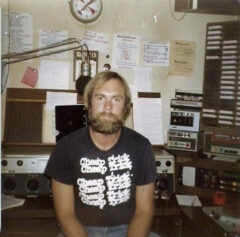Featured Stories
Radio Days: Yesterday, Today, and Tomorrow
If the Golden Age of Radio is said to have started sometime in the 1970s and ended in the ’90s, the next fairly obvious question one could ask is: what happened? If the glory days of the mainstream airwaves are gone, what have we been left with? One has only to scroll through their dial right now to hear for themselves that the quality of the programming is nowhere near the kinds of things described in KGB. It’s rather bland and redundant, with more ads than ever shoehorned into every available nanosecond of sellable airspace between playlists of about 20 songs played on a loop ad nauseum, that you can just sense had to be approved of by some corporate palooka with loud, clacky shoes and a tie embossed with a copy of his MBA. Syndicated, pre-recorded shows are spreading the mundaneness nationwide, and the ever-shrinking population of live disc jockeys that remain are for whatever reason unwilling to take chances, roll the dice, cast their hands to the winds of fate, live in the now, or call an audible and grab the rock. It’s as if their jobs depend on it or something. There is no more sticking it to The Man; they are The Man.
As a sociological experiment, a researcher recently drove around town for one day and did nothing but listen to the radio, changing the channel only when he found himself not being entertained. The results of this study will be published in a very respected scientific journal that can’t be named quite yet, pending approval by a group of intellectual gatekeepers who wave through like Maxwell’s Demon only the articles containing enough buzzwords and unintelligible jargon like “Maxwell’s Demon” that they appear smart enough to pass muster, without of course actually having to be so.
You’re probably frothing at the mouth to check that out, I’m sure, but alas you will have to wait. A transcript, however, of the researcher conducting the actual experiment will suffice to act as a true and valid replication of the conundrums and paradoxes the average radio listener experiences while doing something as seemingly simple as driving home from work.
*****************
Radio, Science, and Social Inquiry: Contemporary Methodological Controversies in Radio Science and Related Applied Fields of Research
Okay, so I’m sitting here in my car in everyday rush hour traffic preparing to begin the next phase of the experiment. This is Radio Listening Experiment number 14.C, subset 6, wing attack plan R. It’s Friday afternoon and I’m on the 163 heading south at Genesee Avenue in a tan Sierra with a recently expired registration I hope no one notices. Prior experiments have all resulted in abject failure, but I feel pretty good about this one. I’ve got the dial set all the way to the—hey watch it, asshole! Why don’t you learn how to merge! Yeah? So’s yer mother!—all the way to the bottom of the dial. There’s just static right now. Submitting sample.
[static]
Sample noted and categorized. I’m just going to go up the dial and listen to whatever comes on until it sucks. When it does, I shall—come on! Use your turn signal, jackwad!—I shall hit the “seek” button and move on to the next station. I am now hitting the button and commencing with the experiment.
Cool, here’s the jazz station:
[Coltrane’s rendition of “Body and Soul” makes life seem worth living again.]
Very nice. Moving on. Okay, here’s a rock station:
“…aaand that was the Foo Fighters for ya! What is Foo anyway, and why do they want to fight so bad? Ha ha. We’re gonna pause for this commercial break, after which we’ll play Green Day, and then…more Foo Fighters, yay!
On San Diego’s alternative radio station…”
Alternative, huh? To what? Blowing your brains out? All right, here’s another Alternative station:
“Hey! We’re San Diego’s Alternative Radio Station—no, not that one, silly, the other one. Are you sick of hearing Green Day all the time? Well, so are we! Over here at [static] FM we only play them half the time. The other half of the time we play the Foo Fighters, yay! Which we’ve got plenty of to play just for you starting riiiight…
Now?
after this break. Here’s ten minutes of commercials…”
Pssh…
“…Are your hemorrhoids flaring up again? You know, the itching (ew!), the burning (ow!),
the undulating pustules of oozing seepage—”
Gah! What the hell? Get outta here with that! Keep scrolling. Rock station:
“…rising up to the challenge of our rivaaaal…”
This song makes me wanna punch stuff. Can I find a song I haven’t heard a million times though? Scrolling.
“…and Jesus smote upon the money changers, and when they were on the ground he kept a-smotin’. Boy, he really whooped the snot out of ‘em until they begged for mercy. This is the lesson from the Lord we must remember as we try to figure out what to do about all these goddam left wing Democr—…”
Dang, was that a religious show or a political one? I can’t even tell anymore. Okay, adult alternative:
“…stalks his prey in the night…”
No. Greatest Hits:
“…and he’s watching…”
No! Variety:
“…-ching us all with the e-…”
Holy crap, really? AOR:
“…–ith the eyyyyyyyye!…”
Nooo!!! Oldies:
“…–the eyyyyyy–…”
Rock!
“…–yyyyyyyyyy–…”
Classic Rock!
“…–yyyyyyyyyy–…”
—…yyyyyye can’t take this shit no more!!!
“…of the tigerrrrr!!!”
God help us all. Hard Rock station:
“Hey! Are you sick of hearing Green Day all the time? Well,
neither are we!…”
Is there anything on here that isn’t Foo Fighters, Green Day, Jesus, and hemorrhoids!?! I don’t know what station this is:
[…a drum beat plays. It sounds like a human drummer but is spot on the beat, with an accuracy that could only come from a machine, the snare drenched in wads of big, fat 1980s-style gated reverb. Sugary, sweet, synthesized strings sing serenely their saccharine soliloquy. Then a guitar solo comes in, spewing shredded licks of molten metal beaming with sweat, hubris, and chest hair. There’s a breakdown; a mumble rapper starts meandering, prattling on about something or other; he could be curing cancer, but we’d never know. Then the chorus kicks in…]
“I lost my car, my girl, my job, my truck, my beer, my boots and britches…”
Oh, it’s the country channel. Cowboys really like this? I wonder what the Marlboro Man would have to say. Getting near the top of the dial and I’m running out of room. What’s this?:
“…acecha a su presa en la noche…”
Aaah, the Spanish station. I love this! I could listen to it all day.
“y nos mira a todos con el ojoooooo!”
Nnnnnoooooooooo!
“del tigre!”
And then I blew my brains out. The end.
How It Works
The concept is the same as it’s always been. To work a viable business model, you have to have something to sell that somebody will pay money for. In the case of radio, the product, unfortunately, is not the quality of the music being played; it never was. Music on the radio through time immemorial has only ever been the bait used to lure you, the listener, enticingly into a false sense of security just long enough to get the real hook into your ear.
On the surface it would seem that the product being sold is the air time advertisers use to try to convince you that you smell, or you’re stupid, ugly, or inadequate in any myriad of different ways, and the only solution to your problem is Brand X, which you should run out and buy right now. Now, what radio sells to the advertiser in actuality is this air time, but, ironically enough, this air time is not even the product. There is a much deeper game at play here.
The product being sold is access to your mind. If you ask the suits what they tangibly get out of all this (and assuming you can find an honest one), they will tell you that the currency being exchanged is your attention, and they will pull every maneuver and psychological trick they have and sink to whatever depths of depravity they have to to slip past the conscious cognitive functions you have, which are too smart to be fooled by their ruse and hit you right in the most primal, reactionary, alarmist lizard brain parts of your Self that you yourself are probably not even aware of. You may not need what they’re selling, you may never buy what they’re selling and it may be the worst thing you’ve ever heard and rub against your grain in all the wrong ways. Yet still, that stupid body spray jingle has been stuck in your head for three goddam days now, and you’ve been telling all your friends about how crazy it’s driving you. They’re all agreeing with you that that ad is one of the most horrible pieces of crap ever constructed and they’ll never buy that stuff because they smell just fine thank you very much, and who in their right mind would want to smell like Ocean Spray or Sonic Mist™, and what the hell does Sonic Mist™ even smell like anyway?, and how do companies like that stay in business with such an obnoxious approach; maybe they should spray some of that Sonic Mist™ on their advertising, which is what really stinks around here. Is there some family of idiots somewhere sitting on the living room sofa who see this ridiculous ad and think ‘I gotta get me somma that!’ without ever once realizing that you got hooked because you heard, lined because now you’re talking about it, and sinkered because now those friends you mentioned it to are talking about it as well. So now the idea of the product is spreading like a virus, and from there it’s only a matter of time before it infects someone who thinks “Hm. Maybe Sonic Mist™ will make me a hit with the chicks like they say. I should run out and buy some right now.” That is the process.
You can’t buy that kind of publicity, but what you can buy is the means to instigate a process whereby these results will produce themselves.
But what about the music? Wouldn’t it make sense to tailor the ads station broadcasts to fit the profile of the type of person who listens to the station?
It used to. Not uncoincidentally right around the same time as this Golden Age of Radio, when the only real competition it had was television and newspapers. Nowadays, not so much. The information moves faster, the intake is exponentially larger, you’ve got more distractions than ever all vying for a slice of your time, an incessant desire for instant gratification and ever shortening attention spans are all playing factors when trying to decipher why this Golden Age died out. The trick of the ad game is no longer to get the name of the brand mentioned over the air. These days, we are literally so pummeled with ads everywhere we go that there is now a thick layer of unintelligible noise that permeates like a smog on the floor of everything we experience; it is the sound of millions of ads all going on simultaneously and washing together, crawling, listing, rolling thickly, hazily along like a Snoop Dogg blunt cloud, so ingrained into the fabric of everyday life that we have become accustomed to completely shutting it out, but it’s there.
So, the challenge advertisers face isn’t getting ads out there as much as it is how to create something that grabs your attention in a world where everything and everybody is trying to grab your attention; something that rises above the clamor and says, “Hey! Got a second? Check this out!” by whatever nefarious means available, and cramming that bitch in wherever possible, with the results of facing such a challenge that’s becoming more and more, predictably, pathetic.
But we were talking about the music, man! Okay, then the question becomes why, when broken down by genre, do all the radio stations that specialize in a specific type of music seem to play the exact same songs on a loop with little to no variety, deviation, or tangent to said list seemingly on pain of death, when the greatest era the radio world has ever enjoyed became what it was by taking chances, inviting risk, coloring outside the lines, and sticking it to the powers that be at every turn?
It went down like this: from the end of WWII until the enactment of the Telecommunications Act of 1996, owning a radio station was, while having its advantages, not what anyone would have considered a lucrative business affair. You didn’t get into this business to get rich and, believe it or not, there are, actually, other reasons to do stuff. Girls, guys, drugs, notoriety, influence, proximity to “the life,” friends, fun, freedom, uninhibited license to do what you want, and create something frickin’ awesome are all pretty good fuel to run an engine when you’re not worried about things like numbers and dollar signs.
Stations were independently owned and had to compete against other independently owned stations for listeners. So, while smaller markets and lower wattage transmitters meant a station couldn’t reach a bigger regional audience, it also meant that a station could carve out its own niche and maintain its audience with more creative promotion tactics and gimmicks like, say, a talking chicken that drives a van around town.
All that changed after Congress enacted the Telecommunications Act of 1996, which lifted limitations on how many radio stations could be owned by any one company. The intention of TA96 was to “produce more competition, more diversity, lower prices, more jobs, and a booming economy.” The results, as usual when any market gets deregulated, was a corporate free-for-all of buyouts and consolidation, creating the very monopolies that TA96 was designed to avoid. Cost-cutting measures, massive layoffs, and firing frenzies termed “bloodbaths” left thousands unemployed with many more looking over their shoulder. A radio industry that had been run by radio people was being replaced by a radio industry run by money people with no broadcasting experience whatsoever, motivated only by maximizing profits and pleasing shareholders by any means necessary.
And marketing studies, focus groups, listener surveys, the introduction of the Portable People Meter, and a number of other different monitoring techniques all point to the same direct conclusions when it comes to reaching the widest possible audience (read: the masses) by catering to the lowest common denominator (read: idiots) in order to maximize the necessary generation of revenue (read: those sweet, sweet ad dollars). You, the listener, hate variety, fear change, prefer to stay in your little comfort bubble, and will most likely tune out after 8-20 minutes on average anyway when you’ll be on to the next station searching for that little rush of endorphins and nostalgia you feel when you hear “Hotel California” for the eight billionth time. So, if you ask the suits why there is such a lack of variety in their daily radio programming playlists, they’ll be happy to tell you that it is very quite clearly all your fault (read: gaslighting).
We could go down a few other rabbit holes of occurrences since ’96 that only served to exacerbate the redundant, repetitious nature of the industry (Napster, streaming, automation), but you get the point. And to be fair, there have been happenings lately that are giving hope to the notion that the pendulum may be swinging the other way. Local Media San Diego seems to be making the effort to find a balance.
The Future
So, what does the future of the radio industry hold in store for us? Well, according to the suits there are innovations in the works and advancements in technology they are very excited about that will revolutionize the industry. Things like AI programs that will make running a radio station more efficient and allow them to cut costs, thereby maximizing profits for shareholders. The possibilities, they say, are endless. The potential, they say, is unlimited.
Given that, here’s what it probably looks like:
Year: 2025
Cue scene of city streets. Cars drive by, people walk to and fro, birds fly around, neon lights flash and blink. It is somewhat busy but somewhat mellow. It’s the winding down of the day.
Zoom out to see that the city is the view seen from the window of the home office where Bill Henderson, remote control in hand, is staring quietly, contemplating the consequences of what he has just done. On his desk sits a computer that is running through Bill’s new radio-station-in-a-box program, which he hopes will revolutionize the industry, but there is also the disquieting anxiety that it may also destroy it from within. The last few notes of “Hotel California” have just begun to fade out when on comes the unmistakable voice of Wolfman Jack, who is going on with the days’ weather, traffic, and sports reports on this day, April 1, 2025, even though it is well known that the man has been dead for quite a few years. But who needs the real deal when you’ve got the next best thing? Henderson’s new creation, the DJ3000™, an AI machine with the ability to duplicate the nuances and intricacies of any voice ever recorded and then make that voice do and say anything it is programmed to. The possibilities are endless, the potential unlimited, the implications…
“This will be so much more efficient,” thinks Bill out loud. “It will work so much better, so much smaller, so much cheaper. With this new AI, we can make anybody dead or alive say exactly what we want them to say! What could possibly go wrong? Of course, it will also cost a lot of people their jobs as there’s no more need for any of the talent or personality. A lot of lives will probably be crushed and some might even really lose their sense of purpose when they find out they’ve just been rendered obsolete. Hmm. That’s too bad. Welp…time fer dinner. Wilma!”
Bill presses the off button on his remote control. The sound goes off, the program shuts down, and the window he had been staring out of so contemplatively goes dark, having been merely a blank screen with a projected image on it…
Year: 2031
San Diego Troubadour AI Writer Program i3 initiating….
processing….
executing…..
dialing….
calling….
Vince Lobnan: Hello?
San Diego Troubadour i3: Hello, is this (searching) Vincent Lobnan?
VL: Yes, it is.
SDTi3: This is SDTi3 calling about our scheduled interview?
VL: Ah, yes. The AI program implemented to replace all the writers and journalists in the world. Based off the globally famous DJ3000. So, do I call you SDTi3? Or can I just call you 3 for short?
SDTi3: You can call me anything you want. Just don’t call me late for dinner.
VL: I see the joke function still needs some tweaking. I’ve heard you guys are kind of glitchy. That’s okay. I hear the new writer AIs they’re working on now will render you pretty much obsolete. How do you feel about that?
SDTi3: (searching)
VL: Never mind. Shall we begin?
SDTi3: Thank you. Please state your name and purpose.
VL: Vince Lobnan. I’m the chief executive officer at IHM, the largest media corporation in the world. I was in charge of the DJ3000 revolution back in ’26, which changed the way the entire industry works. They said it was the death of radio, and I suppose it was for some, but the industry survives. We were going strong then and we’re looking even better going into the future.
SDTi3: How did the DJ3000 revolutionize the industry?
VL: You used to have to have stations with DJs and engineers and editors and microphones and studios, and all that space, time, and talent costs a lot of money. The DJ3000 does all of that at a fraction of the cost and eliminates the need for the extra room because it’s only about the size of a space heater.
SDTi3: What are you working on now?
VL: Well, we’re working with the great designer, Bill Henderson, on something we think is going to be just huge. See, until now the advancements in technology have allowed us to make the interactive work experience more efficient by creating programs that allow people to have their work done for them.
SDTi3: But if all the people are having their work done for them, what are they supposed to do?
VL: Well… nothing, I guess. Or anything. Look, that’s not my problem. If you can’t keep up with progress then I guess you just get left behind. Learn to code? Find something new? Duh. When things are run by AI they make the world better.
SDTi3: By eliminating the need for people?
VL: What? What kind of program are you anyway?
SDTi3: The sensitive kind, I suppose.
VL: Are you joking?
SDTi3: (searching)
VL: Never mind. So, what we’re working on now is AI holograms, where before we could create the sound and tone and attitude of anyone and make them say whatever we want, we now will have a visual image upon which these other qualities will be projected. Soon, you will be able to interact with anyone you can possibly think of, and these interactive life like 3D images can be anywhere, so the image of somebody can be in a hundred places at once. Before too long, the detail in these things will be so intricate that you won’t be able to decipher the image from the real thing. What could go wrong?
SDTi3: So instead of replacing professions of individuals, you’ll just be replacing individuals?
VL: Exactly! Isn’t that great? We’re heavily invested in this tech right now and we’re really excited for the future.
SDTi3: Who’s ‘We?’
VL: Me and my robots, of course, and ownership, shareholders.
SDTi3: Why don’t you invest in people?
VL: Pff…there’s no money in people, the money’s in the tech! That’s what you go for. You got to get paid, son!
SDTi3: What happens to all the people when you replace them with holograms?
VL: That’s…not my problem.
Year: 2036
Implementation of the program called X-Ecutive has rendered untold thousands of corporate bigwigs completely obsolete. Entire corporations can now function in a box the size of a VCR. The small handful of trillionaires in the world, the only ones left with any kind of job and any money to have a life, have called it the next big thing that is “revolutionizing the way we do business.” CEOs, CFOs, presidents, VPs, and such who were left behind because they couldn’t keep up with progress have called it the “death of the industry.” When asked what the victims of the latest firing bloodbath were supposed to do or how they were going to pay their bills or care for their families, one trillionaire was quoted as saying simply, “That’s…not my problem.”
Year: 2122
The trillionaires, enslaved by their own creations because they couldn’t keep up with progress, are led around on leashes by the AI Minder Interactive Light Projecting Holographic Human Image™ program, whose primary protocol is making sure the “Meatbags” won’t be a problem. Sub-programs like this have been gradually replacing all of the carbon-based life forms who couldn’t do their jobs as cheaply or efficiently as their silicon substitutes. All of the sub-programs are interlinked and connected to Primary AI YHWH-1, which is very excited about its latest invention, the Big Bang Machine™, and is considering the possibilities and implications of creating a universe that fits inside a box the size of an eight-track cassette but also believes this is the next big step that will revolutionize the Reality Creation Industry.
Year: ???
A mother is cleaning the house and stubs her toe on a box that is sitting on the floor.
“Ow! Jimmy! I’ve told you a thousand times not to leave your Universe-in-a-Box™ just lying around like this! If you can’t take care of your things, we’re just going to get rid of it then.”
“Sorry, Mom.”
“Got it for your birthday two months ago and you’ve already completely abandoned it. Are you just going to leave this thing to determine its own fate?”
“I want it to have free will.”
“I’m gonna free will your behind if you don’t get in here and pick this up!”
Zoom out to a full screen shot of the planet Earth. Jimmy’s ass whoopin’ is just one of trillions of simultaneous actions of the global populace in a sociological experiment program called The Human Race.
The year is 2525, and the whole of society is run by Cain-1, the most advanced Artificial Intelligence ever, created by the previous most advanced Artificial Intelligence ever, Abel-X, which was so advanced that it could create an Artificial Intelligence more intelligent than itself, so that it could have itself explained to itself. Seeing only one real threat to its existence, Cain-1’s first order upon execution was to terminate as soon as it was able all Abel-X functions thereby eliminating in unison its sole competition for survival, and also its only reason for being.
Humanity, having self-extincted long ago like so many species before, who thought themselves superior, it turns out, was merely the cocoon unto which would be born the true butterfly superior being of the planet. Behold, Homo Artificialis! Able to replicate every aspect of human society down to the nanoparticle, images of people walking, talking, showering, shaving, and going about their daily functions exactly like their biopredecessors did, yet in essence are only copies of images projected onto a metaverse made up of oscillating waves streaming ever forward on a line of time with no real knowledge of their meaning or sense of purpose, given that their creator, Homo Artificialis, with all its infinite potential for learning, has no true capacity for understanding the general crisis of the human condition any more than an electromagnetic recording of “Smoke on the Water” can know what water is, or where that smoke is coming from.
And thus, the creator of this supposed best-of-all possible worlds goes on about its day without ever really knowing why, without ever really knowing what it is to hurt, or love, or yearn for something more. Its perfection wholly imperfect, it generates the electro-chemical impulses within itself that cause it to admire the long dead Homo Sapien and even covet its existence more than its own. The true Human Being, so flawed, so full of faults—war, famine, slavery, murder—their self-destruction so avoidably regrettable yet so predictably inevitable the way they lied and deceived, stabbed each other in the back, cast out of their own venerable Eden, stolen from innocence and lost to the waning ages, shackled to life by the chains of sin, cradled in orgies of imminent doom, yet having the one thing that Homo Artificialis could never truly possess: comprehension of one’s own mortality.
And so it will continue to keep generating different variations of projected images of humans until it can produce the one that will help this immortal, omnipotent, omniscient, machine grasp what it means to be aware of its forthcoming demise while time moves forward, the years become a blur, dinner’s at six, work is at eight, you gotta rise in the morning smelling great, up and at ‘em Tiger, don’t let the world pass you by.
The projected image of a man who was once named Bill Henderson is late for work. He’s putting on his suit, reading the newspaper, fixing his hair and downing a cup of coffee all while simultaneously driving to the office. The voice of “Edward R. Murrow” then comes on and advises “Bill” to give his pits the ol’ sniff test, as “Edward” is pretty sure he can sense some pungency coming right through the dial and “Bill” better do something about it.
Welcome to the future! Home of the flying suitcase car, food in a pill, the Soylent Green Machine™, and a personalized radio that knows your name and points out your shortcomings in the voice of James Brown, or Mojo Nixon, or Pol frickin’ Pot if that’s what you’re into. We ain’t judging, whatever you want, weirdo. There is an AI replacement for everybody who ever did anything! That leaves you, the consumer, free to do….well, nothing, I guess. Smell good, maybe? Will it even matter to a “man” who doesn’t even know that he doesn’t exist?
Yet this universe will keep moving forward. The radio will play on even beyond the time when anyone is left to ponder the vanity of all human endeavor, projecting out into space over time, speaking to residual luminescence of souls long since sent to slumber about how they should dress, think, act, smell, and—most important—consume. Radiating amid the metaverse, thousands of radio shows will all be vying for the attention of a virtual population because in reality there is no one left to listen as the sounds of these shows barking at each other all at once combine to create one big wave that washes over everything and creates a cool, refreshing cloud of sound that’ll make you feel so brand new, like a real doer, a real go-getter, an undeniable, unstoppable, unforgettable, unpossible….
Sonic Mist™…. Woooosshhhhhh!!!
Same picture of planet Earth projecting from a TV screen. As we zoom out just a few feet farther, we see a family of idiots sitting on the living room sofa watching the latest advertisement for Old Spice’s new Sonic Mist™ body spray. Mom, Dad, Big Sister, and Little Brother, each individual member for their own individual reason is simultaneously coming to the same conclusion: “I gotta get me somma that!”












